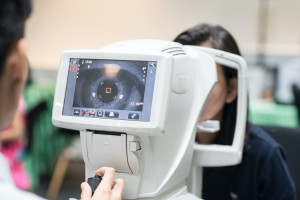A revolution in medical training. Telesurgery supports development, but will not replace traditional surgery.

- Telesurgery, the ability to perform surgery remotely, has captured the imagination for many years. At the same time, it raises significant technical, legal, and ethical concerns.
- Problems with the quality of the internet connection, lack of proper contact with the patient and the risk of complications make remote surgery a very risky undertaking
- The potential of remote connection with robots is not necessarily futuristic procedures, but rather supporting the training of less experienced surgeons - argues Dr. Marek Zawadzki, MD, from the Voivodeship Specialist Hospital in Wrocław.
- The material was created in cooperation with Synektik
Jakub Styczyński, Rynek Zdrowia: Do you have good internet at home? Do streaming movies freeze?
Dr. Marek Zawadzki, MD, PhD, general surgery specialist at the Voivodeship Specialist Hospital in Wrocław: I have a decent one, but of course, the malice of inanimate objects has a way of surprising us at the most inopportune moment. So, right when I need to speak during an important online meeting, my internet tends to freeze.
So you probably wouldn't entrust your entire career to an internet provider and risk potential criminal liability?
As I understand it, you are referring to the possibility of performing operations remotely.
Of course.
The issue of remote surgical procedures is complex, and it's not just about the technical aspects. It's worth remembering that the first telesurgical procedure took place in 2001 and was presented as the future of medicine. It was a relatively simple procedure—the removal of a gallbladder—but it was successful without any complications, despite the considerable distance between New York and Strasbourg. And that was almost a quarter of a century ago.
Later, similar procedures were carried out in Canada, for example, where the distances between residents of different regions necessitated the implementation of remote procedures. Ultimately, however, the idea was abandoned because, in addition to the technical aspects, ethical and legal challenges proved difficult to overcome.
For example?
An issue that remains unresolved today is the division of responsibility during remote surgery. That is, who would take responsibility if the procedure were to fail or serious complications arose? The hospital, the doctor working remotely, the doctor on-site, the robot manufacturer, the internet provider? Or perhaps all of them jointly and severally? This is a significant challenge, considering that we are putting human health, and sometimes even life, at stake.
But there are certainly situations in which the risk could be accepted by the patient himself. For example, if a very complex surgery had to be performed, or if a procedure had to be performed on a soldier near the front, without endangering the experienced surgeon.
Situations can indeed vary, although not every time we would be dealing with a completely remote procedure. It is technically possible for two operators to operate a single robot: one in the operating theater, the other hundreds of kilometers away. They could jointly support, supervise, or assist each other during particularly difficult moments of the procedure.
What would you pay attention to before undertaking telesurgery?
The organization of the operating theater at the hospital where the patient is being operated on would certainly be crucial. I imagine a situation where I'm connected to a hospital hundreds of kilometers away. However, I'd like to know if there are people at the facility who, in the event of bleeding or a network failure, would be able to take over the robot's controls or convert it to a traditional procedure. I'd need to be sure they can handle such a situation. On the other hand, the question arises: if an experienced team is on-site, why doesn't they perform the procedure themselves?
This defeats the purpose of performing telesurgical operations.
That's right. However, innovators are working to address such situations. In Poland, Professor Zbigniew Nawrat's team investigated the possibilities of performing remote procedures. Test connections between the console and the robot were established in cities in Upper Silesia, using standard commercial internet networks. It turned out that the parameters provided by internet providers differ significantly from what actually reaches the recipient – especially during peak traffic hours in the middle of the day.
I've seen these studies. The longer the test operation lasted, the more signal delays occurred and the less stable the connection became.
This would be a very dangerous situation if the operator behind the console saw something different than what was actually happening in the operating field at that moment. Instead of helping, it could lead to further problems.
Imagine the most critical moment of, say, a prostatectomy, when surgery is performed near blood vessels, and one unfortunate move has a dramatic impact on the patient's future quality of life. And then a connection error pops up on the screen. How should the robot react? The AI-powered robot prototype from Zabrze is designed to complete the movement or at least remove instruments from the surgical field.
Surgery is constantly moving towards standardizing surgical procedures. If we actually had parts of the operation that a robot could complete, or if a robot could react if the connection were to be lost, that would be a great solution. However, please remember that life is more complicated than theory, and not everything can be planned.
There are different types of surgeries, different tumors, and anatomical anomalies. In the case of hemorrhage due to a severed blood vessel in the pelvis, the patient can die within 2-3 minutes. Again, in such a situation, I would expect someone in the operating room to take control and resolve the problem before a tragedy occurs. However, these are still technical and organizational considerations, and there is one more important aspect.
Ethical?
That's it. The treatment process isn't just about the surgery. The surgeon should see the patient beforehand, discuss the treatment plan, and answer any questions. Then, they perform the procedure within their team, along with the anesthesiologists and nurses with whom they work daily and understand each other without words. The operating surgeon also has a duty to care for the patient after the surgery. I can't imagine a situation in which a patient, after surgery, can't contact the doctor to whom they previously entrusted their health.
This also creates risks for hospital staff. For example, a bloated abdomen or arrhythmia in a patient after intestinal surgery are seemingly trivial symptoms, but for an experienced surgeon, they may be the first sign that diagnostics for possible abdominal complications are necessary. The surgeon shouldn't be hundreds of kilometers away from the hospital. And even if the specialist needs to travel, the patient should still be able to speak with another doctor who has been involved in the treatment process from the very beginning.
This is likely why the surgical community is increasingly openly criticizing the phenomenon of "excisional surgeons," or hired operators performing procedures in various hospitals. Professor Piotr Chłosta, head of the Department and Clinic of Urology at the Jagiellonian University Medical College in Krakow, spoke about them. The point is that hired surgeons leave the patient to local medical personnel, who have no idea what exactly was done and what the potential complications might be. Telesurgery would undoubtedly exacerbate this phenomenon, and efforts should be made to curtail it.
Yes, it's a very unfavorable situation when a surgeon leaves the hospital after surgery. This means that the patient is being cared for by doctors who weren't involved in the operation and don't have a complete understanding of the situation. Even seemingly insignificant details can be crucial.
Remote options will speed up your experience gainThe risks you mentioned suggest that telesurgery can only be used in particularly difficult cases or in emergency situations.
Not only that. In my opinion, it's also an ideal tool for surgical training. Currently, surgeons earn certificates confirming their skills in operating medical robots, training on simulators and in training centers. Then they go to observe procedures, and then perform their first surgeries under the supervision of an experienced operator. And that's where the training ends.
And yet, like any activity—riding a bike or swimming—skills and proficiency improve over time. When a robot operator is left alone, he or she independently performs the fifth, tenth, or thirtieth operation.
We're talking about a learning curve here. It's safe to assume that a surgeon needs a certain number of surgeries to reach expert level. There are varying reports on this – let's assume we're talking about the first 70-100 independent procedures. These initial surgeries are therefore somewhat "suboptimal" and may take longer. But this could be changed. For example, an expert surgeon could remotely join the 10th, 20th, or 30th surgery and support a less experienced surgeon. This would allow them to reach expert level much faster.
What would this look like?
There are already technical solutions thanks to which an experienced mentor surgeon can connect with another distant hospital and supervise the operation, e.g., mark certain points on the operator's screen, place digital indicators, and, of course, communicate by voice, while also having an independent view of the surgical field.
From a training perspective, this is an excellent solution. Please remember that surgeons are usually very busy people. And when I'm personally asked to supervise procedures in Warsaw, for example, the entire process sometimes takes three days. I have to travel from Wrocław, then participate in the surgeries for a day or two, and then return to my hospital. With telesurgery, I could spend just two or three hours remotely supervising the surgical procedure before returning to my daily duties. This solution has great potential and promises to significantly improve the training of young surgeons.
It is probably too early for full-scale remote treatments, but the training direction is definitely worth exploring today.
The material was created in cooperation with Synektik
Write to the author: [email protected]
Copyrighted material - reprint rules are specified in the regulations .
rynekzdrowia












